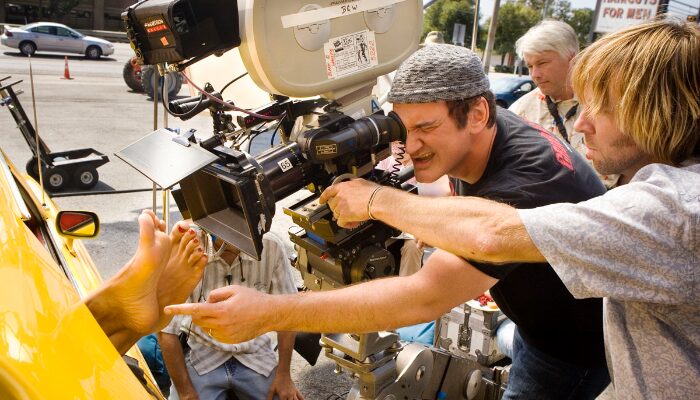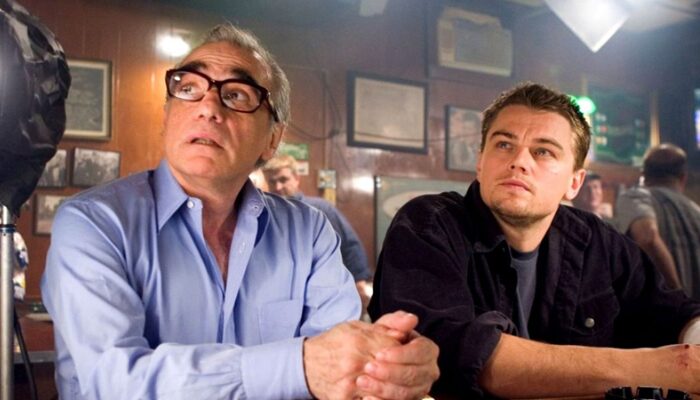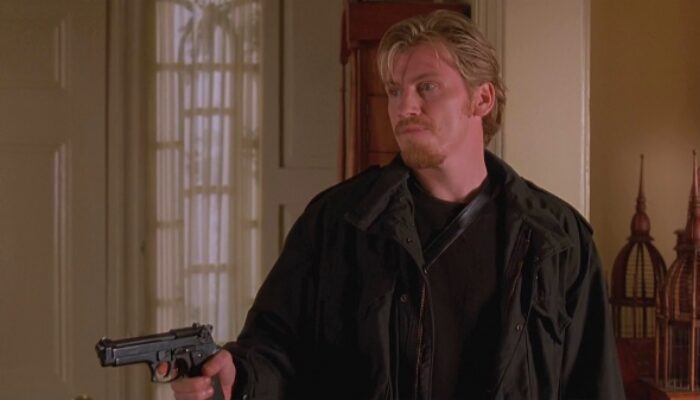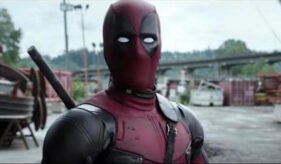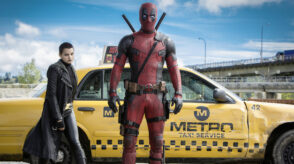Film Review: DEADPOOL (2016): Strong Drama & Comedy Buttress a Unique Adaptation
Deadpool Review
Deadpool (2016) Film Review, a movie directed by Tim Miller, and starring Ryan Reynolds, Morena Baccarin, Ed Skrein, Gina Carano, Brianna Hildebrand, T.J. Miller, Rachel Sheen, Leslie Uggams, Karan Soni, Paul Lazenby, Sean Quan, Andre Tricoteux, Taylor Hickson, Jed Rees, and Ben Wilkinson.
Deadpool was a unique superhero film. It made fun of itself, its lead actor, and actors in other superhero films (as well as the comic book films they appeared in). Deadpool was a film that knew no bounds of taste. Deadpool wrote its own rules from the moment the irreverent title sequence began. When it did, the viewer knew they were in store for something quite different and they received that in droves.
The film’s title sequence was something unlike the viewer had ever seen before and it established the laconic tone for the rest of the film. The character that powered that tone and carried it to fruition was Wade Wilson / Deadpool (Ryan Reynolds), a person that always had something to say in any situation, as if he were a comedian that was ‘always on.’ This particular comedian was saddled with combat skills that he had no qualms about using for payment up-front.
No one was save from Deadpool’s sarcasm, including the audience, who Deadpool turned and spoke to on a regular basis. No situation was present that Deadpool could not turn into a short skit of painful, this-should-not-be-funny-but-it-is moment.
The pinnacle of that would have to be when Deadpool was stabbed in the head and cartoons began, illustrating how his brain had been affected by the serrated metal stuck in it. When Deadpool began making a certain profane gesture with his fingers and Vanessa Carlysle (Morena Baccarin) responded with profanity, the viewer could not help as an audience member but laugh.
One moment in the film handled comically, thus detrimentally, was when Deadpool cut off his own hand, registering no pain or agony i.e. 127 Hours similar scene. That moment would have been served far better if Deadpool was in agony as he went about his work yet restrained his screams instead of presenting himself as an unfeeling, irritated robot shucking corn.
The joke about only being able to afford two X-Men was hilarious but it introduced three problems: 1.) How did the Peter Rasputin / Colossus (Stefan Kapicic) and Ellie Phimister / Negasonic Teenage Warhead (Brianna Hildebrand) get to the televised Deadpool / highway brawl before the police?, 2.) Where were the police?, 3.) Viewers learned about the budget limitations of the film from Deadpool in the film. If the film’s budget was such an issue, why spend so much money on a fully CGI character (Colossus), instead of hiring the actor (Daniel Cudmore) that played him three times already? Cudmore would have cost far less than a CGI Colossus and that money could have gone to having more X-Men on-screen, to more of Ajax’s minions (there were originally supposed to be three of them), et cetera.
When Wade Wilson needed to be serious, all of his comedic fervor fell into a dead, foreboding stare. It only happened twice in the film but it let the viewer know that under the humor, was a feeling human being. That aspect of Deadpool was ameliorated by his relationship to Vanessa and the lengths he went to in order to perverse that relationship.
Vanessa and Wade grounded the film in something relatable (love, affection, and what terminal cancer meant for a couple) and propelled it forward. Wade’s most important action in the film was based upon his affection for Vanessa and compassion. That was what got him through the mutation tortures, why he continued to fight when he thought all was lost.
In that respect, the flashbacks in non-linear Deadpool were even more powerful than many of the present day sequences, which were far more comedic and action-heavy than what had incited them.
When Vanessa and Wade swapped childhood abuse stories, each trying to match and one-up the other (almost proud of what they had endured and survived), the viewer would have felt sad for those two individuals, especially considering what one of them became because of it, were it not for the fact that it also made them perfect for each other.
Francis Freeman / Ajax (Ed Skrein)’s laboratory, the horror movie aspect of the Deadpool, was unsanitary, poorly-lit and resembled more closely what it actually was – a place of torture and horror. Wade noticed it immediately (he was not in a hospital) but didn’t grasp what he was seeing until he was told – à la Wolverine about his past – and it was too late.
Deadpool didn’t possess villains bent on the trope of world domination or destruction, the third act plotline of both Avengers films and numerous other comic book and James Bond films. Ajax and Angel Dust (Gina Carano) were slave creators and slave merchants whose only motivation was the acquisition of money. Capitalists Slavers or in 21th century terms, Human Traffickers (though Mutant Traffickers is more apt). This motivation for their actions cemented both of these villains in a world of economic pushes and pulls but it didn’t explain how they acquired their abilities or became the mutant lab’s puppet masters. Were they recruited like Wade or were they always in charge and decided to ‘treat’ themselves to acquire new abilities? Ah, if only those plot points had been explained but screenwriters rarely see the need to explain evil or explore a villain’s past.
If they had, Deadpool writers Rhett Reese and Paul Wernick might have had to explain why Angel Dust was invulnerable (e.g. the Colossus fight) and why Ajax had super strength (e.g. bending the iron bar) when the former’s mutant ability was supposedly strength and the latter was reflexes, agility, and not feeling anything. Since Wade was given a Wolverine-like Healing Factor, in addition to reflexes, and strength, the aforementioned villains getting multiple, undisclosed ‘gifts’ is not inconceivable but the mind boggled when many people either healed quickly or seemed indestructible in the last two acts of the film.
An aspect of Deadpool that was not confounding was Ajax’s ability to use Wade against Wade, illuminating for the viewer more of Wade’s past, while illustrating the fact that Wade would be the last person the government would ever give superpowers to for any reason. The fact that Wade believed that for a moment showed how stupid, naive, and desperate Wade had become. A smarter man would have asked “Why me?,” looking the gift horse square in the mouth. That same man would not have taken the “Because you’re dying” reply for an answer.
Wade took what an enigma (Recruiter – played by Jed Rees) offered him at face value with no reconnaissance or due diligence of any kind. For a former Special Forces operative, this made little sense. Why didn’t Wade run a background check on Recruiter or conduct basic surveillance to see where he might be taken for this cure? Because of the tight level of drama that occurred in Ajax’s laboratory and the characters introduced, including a sympathetic fellow test subject, those logic oversights from a former Special Ops professional were forgiven (I would rather watch Deadpool‘s lab scenes over and over again than all of the Wolverine movies, Avengers: Age of Ultron, the third X-Men movie, the last two Spider-Man films, all three – technically four – Fantastic Four films, all three The Punisher films, Guardians of the Galaxy, and both Thor films).
One of the highlights of the laboratory segment of the film was the naked fire fight. If Deadpool had not been Rated R, the naked aspect of that fight would not have been possible. The camera would have kept certain ‘things’ off-screen. Because of the nudity, a ‘real’ element was added to the fight that would not have been present or possible otherwise.
The fire in the lab (and Wade Wilson not being burned alive in his test tube) was dubious. Where was the water or advanced fire suppression system in that laboratory? A fire broke out in a lab full of expensive equipment and nothing happened. The writers want the viewer to believe that smart scientists set up a laboratory in a clandestine location with no sprinkler system of any kind. If these ‘scientists’ hadn’t been so reckless (or the writers so lazy – two seconds of “water suppression system offline” flashing on-screen would have solved this), the film wouldn’t have had the fire fight or at least not a lengthy one. Because of what was created by it, once again, the writers’ logic oversight was forgiven.
Something that the viewer could not forgive was the disappearance.
After Colossus carried Negasonic Teenage Warhead and Angel Dust out of the collapsing junk yard, what happened to Angel Dust? After Colossus escaped the destruction of junk yard, Angel Dust disappeared. Colossus was holding her unconscious body. Where did she go?
Characters disappearing with no explanation is sadly common in the badly-written sections of motion pictures, with screenwriters (and editors) hoping the audience will not notice (or care). I had hoped that screenwriters had dispensed with this deleterious practice but since it was convenient and narratively time-saving, Deadpool‘s writers apparently couldn’t resist (unless Angel Dust’s last scene was cut from the film) and created a plot-hole in the process. It was an unforced error that could have been easily erased with a shot of Angel Dust in handcuffs on the ground or unconscious at Colossus’ feet. Oh well. In the end, Deadpool was an entertaining film, surprising at times, near the very top of comic book adaptations. As Wade Wilson would say, “cue the music.”
Rating: 9/10
Leave your thoughts on this Deadpool Review and the film below in the comments section. Readers seeking more film reviews can visit our Movie Review Page, our Movie Review Facebook Page, and our Movie Review Google+ Page. Want up-to-the-minute notifications? FilmBook staff members publish articles by Email, Twitter, Tumblr, Google+, and Facebook.
Related Articles
FilmBook's Newsletter
Subscribe to FilmBook’s Daily Newsletter for the latest news!


